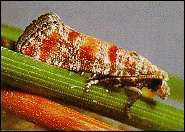
Host: Loblolly, shortleaf, slash and Virginia pine.
Importance: The Nantucket pine tip moth (Rhyacionia frustrana) often causes severe damage to buds and shoots of pine seedlings and small saplings. Vigorous seedlings may grow fast enough to overcome effects of the insect, but severe and repeated setbacks may result in stunted, deformed trees of little value, especially on poor sites. Tree mortality is usually very light, however, and tip moth attacks usually cease when the tree reaches a height of 10 - 12 feet.
Identification: The ¼ inch long adult moth is mixed gray and shiny copper colored and has a wingspan of ½ inch. They are active from February until late fall, but not often seen unless disturbed. White to orange eggs are laid on needles and twigs. Larvae are yellowish to pale brown, worm-like, and up to 3/8 inch long. They feed within buds and twigs, later changing into brown, capsule-like pupae about 1/4 inch long.
Signs of Attack: The most noticeable and usually the first sign of attack is browning and dying of infested shoots. Close examination of these shoots will reveal an accumulation of resin and fine webbing. When shoots or buds are broken open, they are hollow; and larvae, pupae or empty pupa cases may be observed if adult moths have emerged.
Life Cycle: Adult moths mate and lay eggs between January and March, although the incubation period may be prolonged if cool weather persists. Newly hatched larvae feed on new growth for a short time before boring into the shoot. Larvae continue to feed in the shoots until maturity and then pupate in hollow feeding cavities. Four or five generations occur each year. The largest population and most twig damage occur during the first two generations.
Control: Control is usually impractical for forest trees; however, severe and repeated infestations for 2 or more years may require chemical application. For high value trees in seed orchards and genetic studies a control treatment is generally implemented. Homeowners can readily prevent and control infestations with registered insecticides. If chemical controls are used, the most important consideration is timing. Contact insecticides like Pounce and Sevin should be applied before eggs hatch so young larvae are subjected to a lethal dose of poison before entering the shoot. Control of the first generation will usually permit trees to make good initial growth and lessen damage from attack the rest of the year. Systemic insecticides like PTM are more effective and less restricted by timing but economic feasibility is a concern. Another method of control is placing pheromone traps in late winter to catch moths as they hatch. As soon as the first moth is caught, begin spraying.
Photo Credits: David T. Almquist, University of Florida; Tim Tigner, Virginia Department of Forestry; G. Keith Douce, The University of Georgia, ForestryImages.Org
Additional Resources